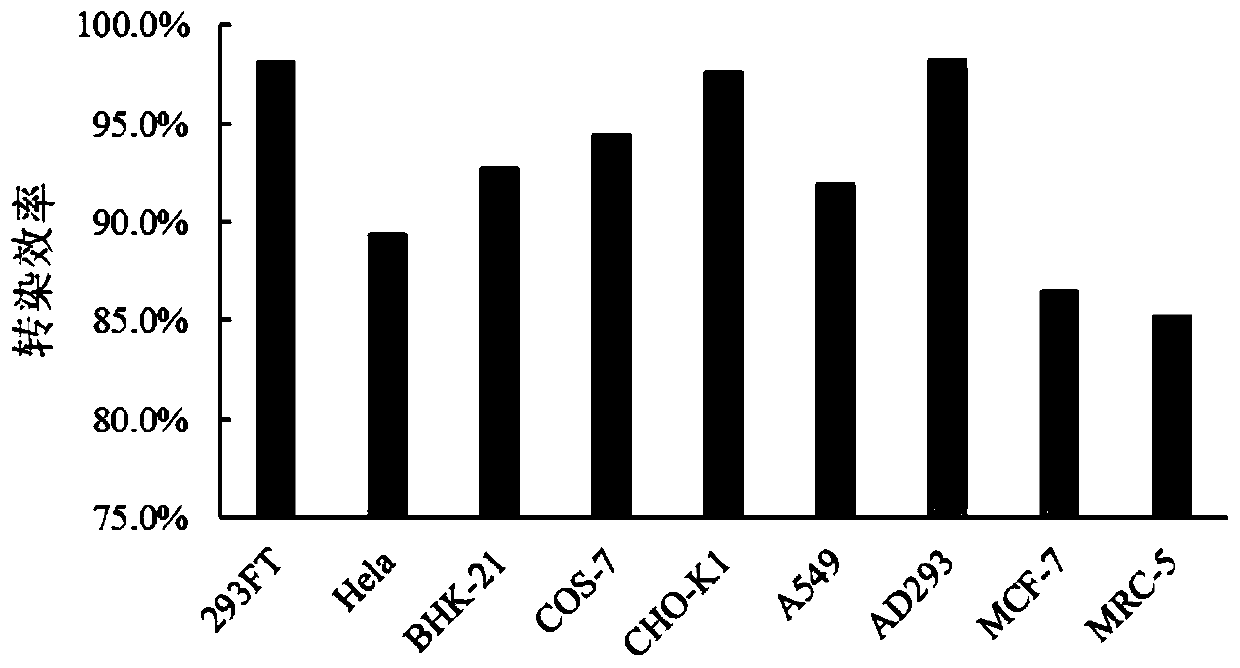A kind of cationic transfection reagent and its preparation method and application
A transfection reagent, a cationic technology, applied in the field of genetic engineering, can solve problems such as inability to pass on time, time-consuming transfection operation, and increase in cell survival rate, so as to reduce cytotoxicity, optimize components, and improve Effect of transfection efficiency
- Summary
- Abstract
- Description
- Claims
- Application Information
AI Technical Summary
Problems solved by technology
Method used
Image
Examples
Embodiment 1
[0041] Embodiment 1: a kind of cationic transfection reagent and its preparation
[0042] A preparation method of a cationic transfection reagent comprises the following steps:
[0043] (1) Dissolve polyethyleneimine and cationic polyacrylamide in PBS buffer in proportion, stir at room temperature for 15 minutes, mix evenly, and filter with a 0.2 μm filter to obtain mixed solution 1, in which polyethyleneimine and cationic polyacrylamide are The concentrations of acrylamide were 10ng / mL and 20ng / mL, respectively;
[0044] (2) dissolving didodecyl dimethyl ammonium bromide and vitamin D in 85% ethanol aqueous solution in proportion, stirring at room temperature for 20 min, mixing uniformly, and filtering with a 0.2 μm membrane to obtain mixed solution 2, wherein The concentrations of didodecyldimethylammonium bromide and vitamin D were 20 ng / mL and 10 ng / mL, respectively;
[0045] (3) Mixing the mixed solution 1 obtained in step (1) and the mixed solution 2 obtained in step (...
Embodiment 2
[0047] Example 2: A cationic transfection reagent and its preparation
[0048] A preparation method of a cationic transfection reagent comprises the following steps:
[0049] (1) Dissolve polyethyleneimine and cationic polyacrylamide in PBS buffer in proportion, stir at room temperature for 15 minutes, mix evenly, and filter with a 0.2 μm filter to obtain mixed solution 1, in which polyethyleneimine and cationic polyacrylamide are The concentrations of acrylamide were 20ng / mL and 10ng / mL, respectively;
[0050] (2) Dissolve dioleoylphosphatidylethanolamine and vitamin D in an 85% ethanol aqueous solution in proportion, stir at room temperature for 20 minutes, mix well, and filter with a 0.2 μm membrane to obtain mixed solution 2, wherein dioleoylphosphatidyl The concentrations of ethanolamine and vitamin D were 40 ng / mL and 4 ng / mL, respectively;
[0051] (3) Mix equal volume of mixed solution 1 obtained in step (1) and mixed solution 2 obtained in step (2), add fatty alcoho...
Embodiment 3
[0053] Embodiment 3: a kind of cationic transfection reagent and its preparation
[0054] A preparation method of a cationic transfection reagent comprises the following steps:
[0055] (1) Dissolve polyethyleneimine and cationic polyacrylamide in PBS buffer in proportion, stir at room temperature for 15 minutes, mix evenly, and filter with a 0.2 μm filter to obtain mixed solution 1, in which polyethyleneimine and cationic polyacrylamide are The concentrations of acrylamide were 30ng / mL and 6ng / mL, respectively;
[0056] (2) dissolving dioctadecylaminoglycylcarboxyspermine and vitamin D in an 85% ethanol aqueous solution in proportion, stirring at room temperature for 20min, mixing evenly, and filtering with a 0.2 μm membrane to obtain mixed solution 2, The concentrations of dioctadecylaminoglycylcarboxyspermine and vitamin D were 60ng / mL and 2ng / mL, respectively;
[0057] (3) Mix equal volume of mixed solution 1 obtained in step (1) and mixed solution 2 obtained in step (2)...
PUM
 Login to View More
Login to View More Abstract
Description
Claims
Application Information
 Login to View More
Login to View More - R&D
- Intellectual Property
- Life Sciences
- Materials
- Tech Scout
- Unparalleled Data Quality
- Higher Quality Content
- 60% Fewer Hallucinations
Browse by: Latest US Patents, China's latest patents, Technical Efficacy Thesaurus, Application Domain, Technology Topic, Popular Technical Reports.
© 2025 PatSnap. All rights reserved.Legal|Privacy policy|Modern Slavery Act Transparency Statement|Sitemap|About US| Contact US: help@patsnap.com



